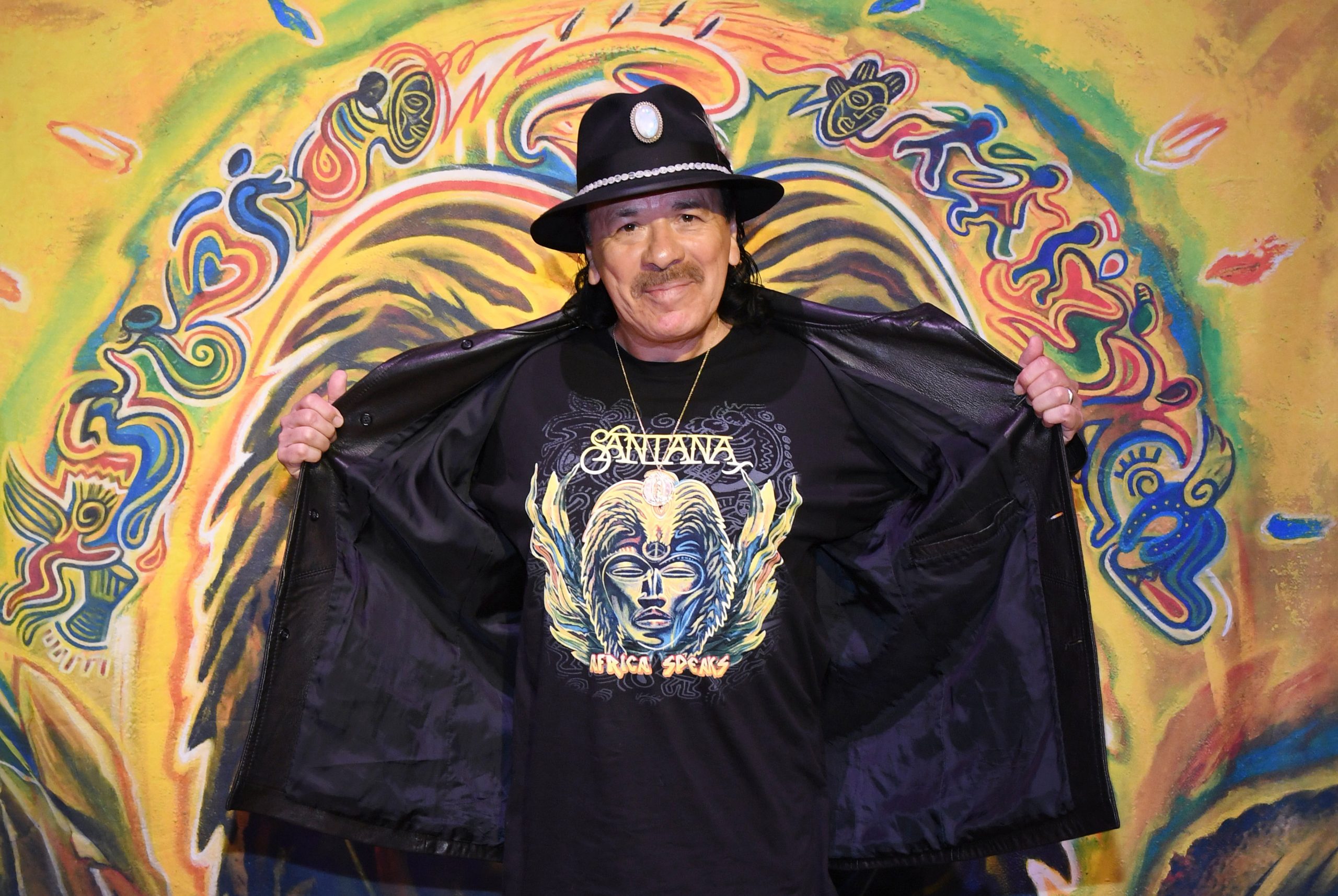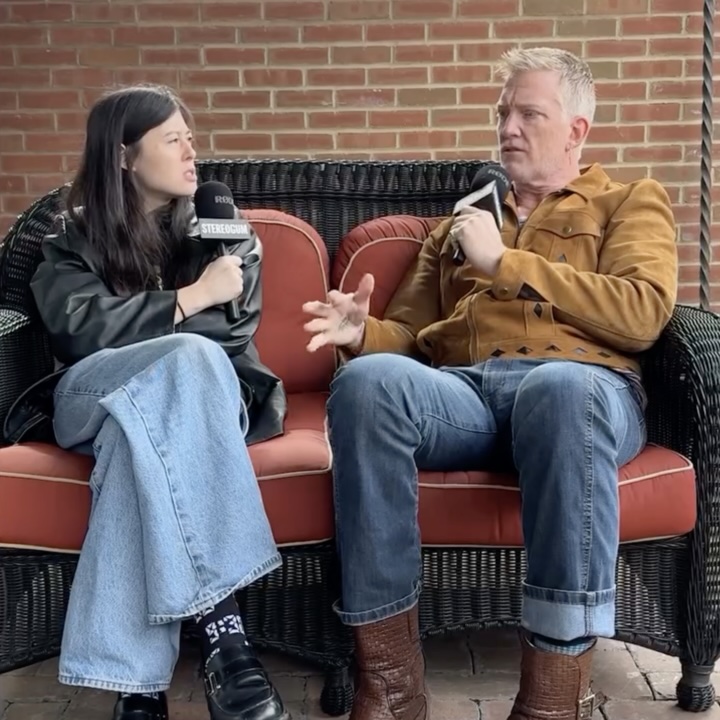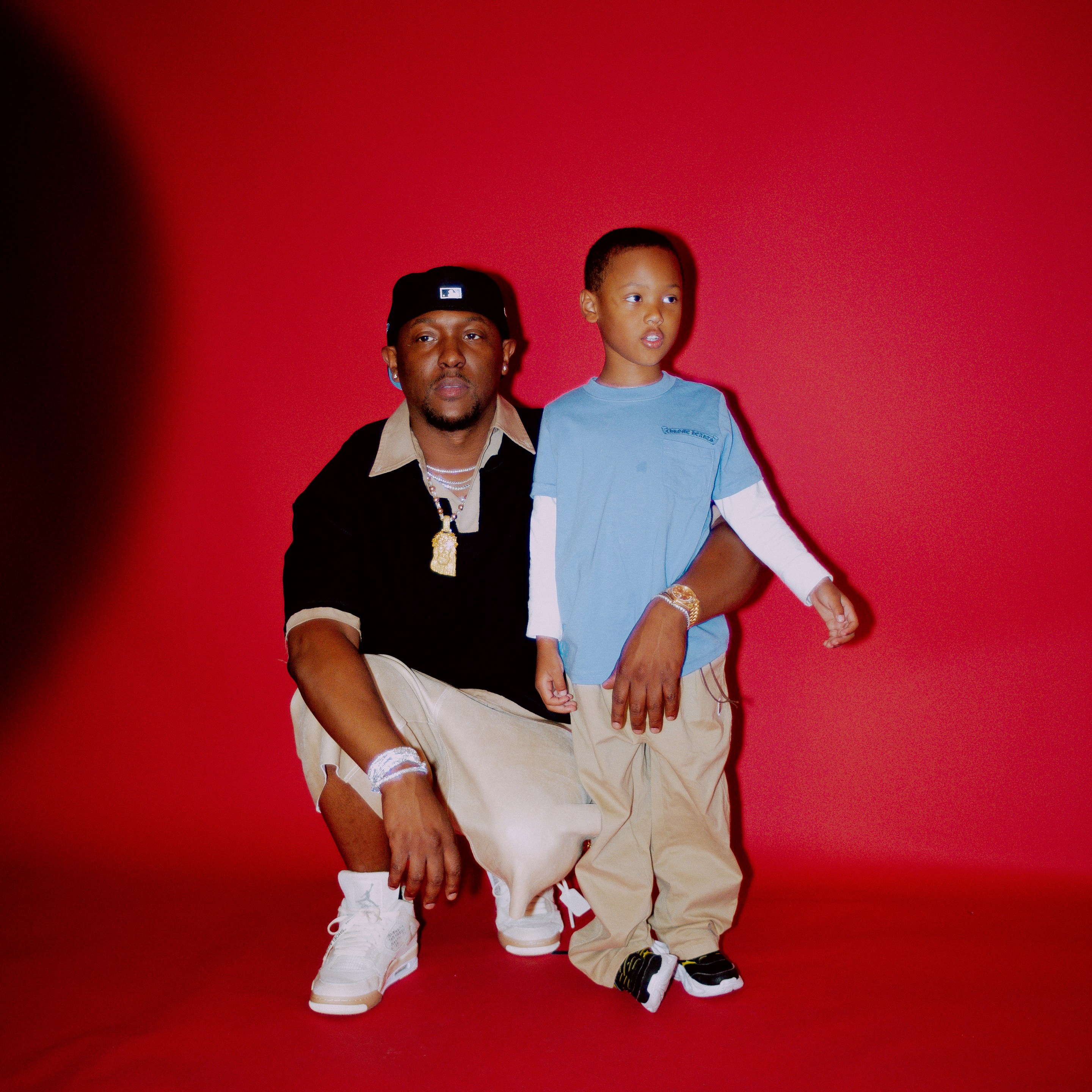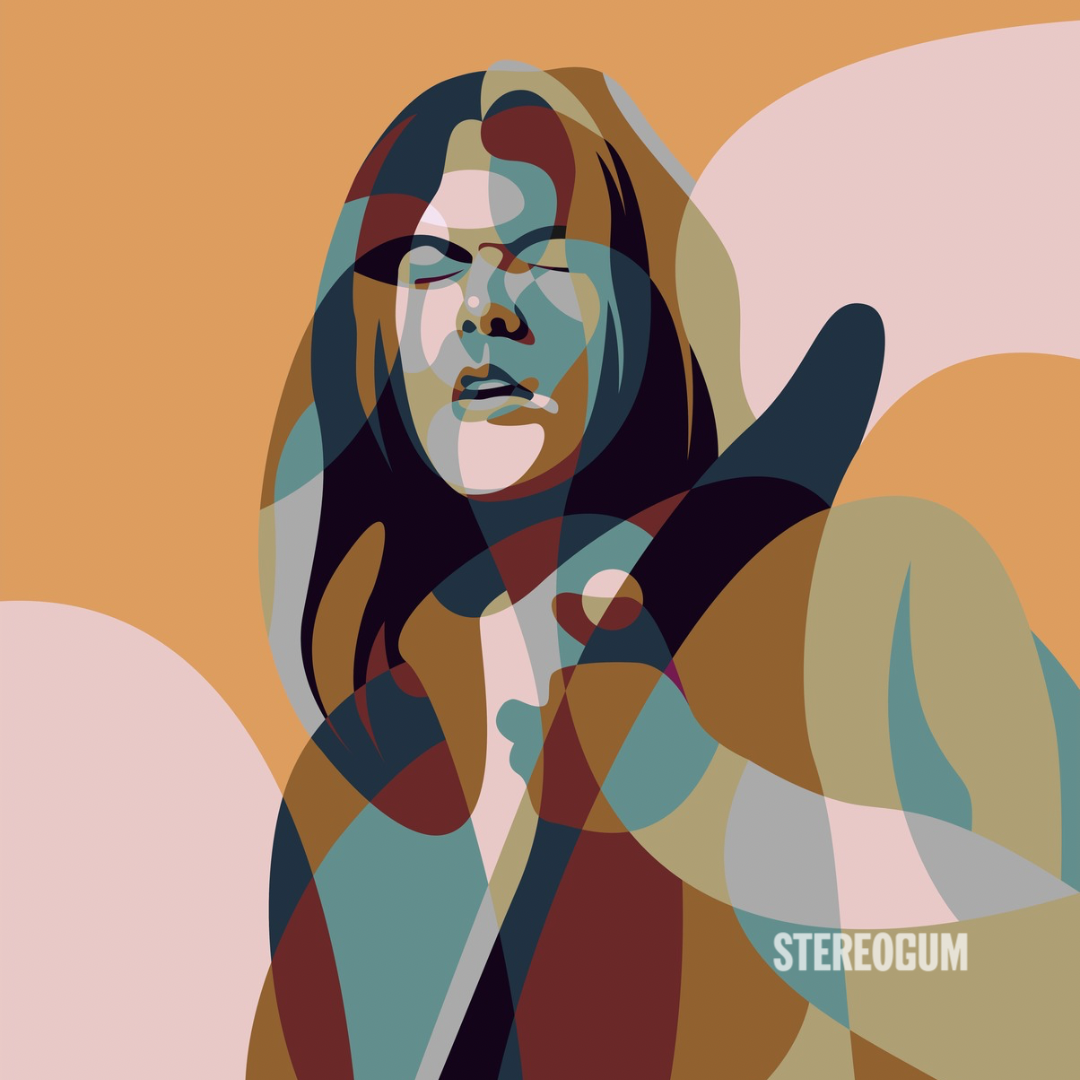Carlos Santana has a lot to celebrate in 2019. It's the 50th anniversary of his band's self-titled debut album, which was released on August 30, 1969. Two weeks before that, the band gave a legendary performance at the Woodstock festival in upstate New York. They'd been a popular live act in San Francisco, but their explosive Woodstock set blew them up into a national act. 2019 is also the 20th anniversary of Santana's most commercially successful album (and one of the most popular albums of all time), 1999's Supernatural, which we'll talk about next week. It would be easy for him to settle into a retro groove, playing the hits while Boomers are still willing to pay for super deluxe ticket packages.
Instead, he's releasing one of the most surprising albums of his career. Africa Speaks, out 6/7, features his current live band -- rhythm guitarist Tommy Anthony, keyboardist David Mathews, bassist Benny Reitveld, percussionist Karl Perazzo, and drummer Cindy Blackman Santana -- and two very special guests. The primary vocalist is Buika, a Spanish singer whose hoarse, crying style combines flamenco, soul, and African music, while British singer Laura Mvula backs her up on several tracks. Buika sings mostly in Spanish, with one or two songs in English and one in the Nigerian language of Yoruba. The album was recorded with Rick Rubin in a rush of inspiration; the band cranked out almost 50 songs in 10 days.
The music on Africa Speaks is raw and powerful, and makes absolutely no concessions to radio (the first single, "Los Invisibles," was the song in Yoruba). The intricate Latin-funk fusion of his mid-'70s albums has been replaced by churning hard rock that's recorded hot and mixed tightly, the instruments packed so closely together that it almost sounds like it's in mono at certain points. Cindy Blackman Santana's high-impact drumming drives the whole thing, combined with Perazzo's percussion and Reitveld's deep bass lines, and Mathews' organ and synths, create a swirling sound that's steeped in the blues, but deeply infused with an African rock sound that could have come straight out of 1970s Nigeria. And Santana himself is playing some of the dirtiest guitar of his career, unleashing one snarling outburst after another.
I talked to Santana by phone from his home in Las Vegas (he's currently in the middle of a multi-year residency at the Mandalay Bay casino, which he'll be interrupting for a summer US tour) about Africa Speaks, his 1970s fusion work -- including Illuminations, a 1974 collaboration with Alice Coltrane, and the Japanese live album Lotus, which was released that same year -- and more.
[videoembed size="full_width" alignment="center"][/videoembed]
STEREOGUM: The first single from Africa Speaks is "Los Invisibles," which is sung in Yoruba. That's a pretty ballsy move. What made you decide to do that?
SANTANA: I've been wanting to do this since we recorded the first album, with [Babatunde Olatunji's] "Jingo." I've been playing African music since I can remember, even when I was living in Tijuana. When I lived in Tijuana, I learned about musica tropical -- at that time there was no salsa, it was just music from the Caribbean -- and every time I heard, whether it was Ben E. King or Jackie Wilson or anybody, especially blues musicians, I always felt that it was African music. It's American-African, because the root and the template and the resonance, it comes from Yoruba. Everything goes to Yoruba -- danzon, mambo, cha-cha-cha, cumbia, anything you can think of that has rhythm or a beat, from Brazil to everywhere, it really comes from Africa. So I wanted to do an album that was purely African music, and it wasn't until we found Cindy Blackman Santana, my wife, to play drums on it, and then this band and Buika and Laura Mvula and Rick Rubin... I had to wait for the grand design to inwardly put all the pieces together, and now we did it.
STEREOGUM: Your guitar sound on this album is really dirty -- you almost sound like Billy Gibbons at times. Are you using different gear, a new pedal, anything like that?
SANTANA: I basically used a wah-wah a lot, and I played through a Strat a lot, a street-mutt Frankenstein kind of Strat that I found in this store in Chicago. Yes, my guitar sounds like claws and teeth, and at first it concerned me, because I didn't know if people were going to be put off, because it's so trebly and piercing, but then I said, you know what? This is OK. It goes with the congas, it goes with Buika's voice -- leave it. I overdubbed maybe 10 percent, the rest happened when it happened.
STEREOGUM: Where did the idea to make a whole album with Buika come from?
SANTANA: I first got the idea from the Virgin Megastore in Paris. I was on the road, on tour with Mr. Wayne Shorter, and I would just raid all the African CDs. So I got the idea way back then to only honor this music like that, but it took a while. Buika, I discovered her at like three o'clock in the morning [and] as soon as I heard her voice, I woke up my wife, "Cindy, you gotta listen to this." So we took her CD, put it in the car, we drove to Napa to spend the weekend, and the more I heard Buika, the more I knew I had to create with her. So when we were doing this thing, 49 songs with Rick [Rubin], he said, "You know, on Supernatural you had a bunch of guests -- who do you want on this one?" I said, "I only want two women, Buika and Laura Mvula."
STEREOGUM: So they flew in and worked with you live in the room?
SANTANA: Truth to tell, the first five days, we recorded all the songs and then we -- the band, myself, and Cindy -- we went to Australia and New Zealand, and Buika came into Shangri-La, Rick Rubin's studio. When she heard the music, she held my hand way later and said, "Maestro, when I heard the music I heard everything I needed to do -- the melodies, the lyrics, and everything. I have never done anything like this in my life. This music made me do it." So I wasn't in the room when she recorded all these things, but it just became so symbiotic. And then we came back and recorded some more songs, and she came back and did it again, and the third time we actually shook hands and looked eye to eye and I thanked her. With Laura Mvula, she came in and recorded, but I have yet to meet her or even shake hands with her. With Buika, it goes to show you that the spirit knows no distance. When you hear Buika's voice and Laura's voice and my voice, it's all there, even though we didn't do it at the same time.
[videoembed size="full_width" alignment="center"][/videoembed]
STEREOGUM: Do you like singing? Because I know a lot of other guitar players, like Hendrix didn't like his singing voice, and Robin Trower used to have someone else sing, and Robert Fripp has never sung...
SANTANA: I think once in a while, I like the sound of my voice because it has, like, an innocence, because you don't know -- that's what innocence is, not knowing and being vulnerable. But many times I trust other singers to interpret what I'm trying to say better.
STEREOGUM: Did you and Buika collaborate on the lyrics, or did you leave it up to her?
SANTANA: I left it all up to Buika for the most part, and every second of every song -- every melody, everything that she did, surprised me. I want to talk about something up ahead that I want to do. Here in Las Vegas where I live, they have conventions for everything, electronics, this and that, but there's not one for shamans. I want to have a shaman convention, and I want to utilize this music, because this music, especially the last song ["Candomble Cumbele"] -- this whole album is about ritual, divine ritual, whether it's the Pope, or Christmas Eve, or the blood of Christ sacrificed for the sins of the world, that's called voodoo, it's a sacrifice, just like in Haiti and Africa. So to me this album, Africa Speaks, when people say, "If Africa Speaks, what is it saying to you, Carlos?" I say, "Africa is saying to me, bring hope and courage to the listener and give them encouragement." Bring hope and courage to the listener. That's what ritual is. Because you have the ritual of connecting your iPhone to the laptop, and when you do it you meet up. Ritual is when you meet up to absoluteness, the beyond, the non-tangible tangible. And for me this album, more than Abraxas or anything I've ever done, is true to the ritual of allowing your heart to be part of that flow. This was a flow that Rick and I and Buika and Cindy ... it was outside of what we could think, and we just became instruments for this particular statement.
STEREOGUM: Your music has always had that quality. I mean, Lotus begins like a ritual, with gongs and keyboards -- it's not like a typical rock concert where you flip the switch and come out blazing.
SANTANA: Yeah, '73 was part of that... what some friends of mine call "career suicide." I've been accused of committing career suicide six or seven times, but for me it's about learning. I want to stay that seven-year-old child that's thirsty for adventure, and sometimes it's gonna go to radio and sometimes it's not. But the main thing is to be true to what your heart wants to do.
[videoembed size="full_width" alignment="center"][/videoembed]
STEREOGUM: The expanded version of Lotus, from 2017, is amazing. Was that a project you initiated, or did Sony Japan tell you they had extra material in the vault?
SANTANA: It was all of the above. We thought they were gonna release all of it. I just feel really grateful, again -- I learned so much from Doug Rauch and Michael Shrieve, Tom Costa, Richard Kermode, especially Armando Peraza, Chepito [Areas], and Leon Thomas. I mean, I have never heard anybody sing "Black Magic Woman" like Leon Thomas. That's like a whole other level of maturity. I love Leon Thomas, man.
STEREOGUM: What are your memories of making the Illuminations album in 1974, and working with Alice Coltrane? Did you spend time at her spiritual center?
SANTANA: Yes, I spent a whole week at her house and we would wake up at 2:30 in the morning and meditate, and she would play the harp and then the piano and the Wurlitzer organ. I learned so much by being around her, especially the way she was writing for this symphonic thing. For me, that album -- thanks for mentioning it -- being around Alice Coltrane and Jack DeJohnette and Dave Holland and Armando Peraza, it made me feel like I was in the minor leagues with Abraxas, and now I'm in the big leagues because I'm with these musicians who I felt were equipped to swim in the Pacific Ocean. I've said this before: There's the Pacific Ocean, there's a big lake, there's a swimming pool, and then there's a bathtub. And I was moving between the bathtub and the swimming pool until I started hanging around with them, and I was like, "Wow. How do they do this work? How do they articulate with such facility and incredible skill?" So being around Alice Coltrane and John McLaughlin, and then of course Wayne [Shorter] and Herbie [Hancock], it really opened me up to improvisation in a whole different way than I'd ever known.
[videoembed size="full_width" alignment="center"][/videoembed]
STEREOGUM: Your wife's drumming on this album is fantastic. She does everything: rock, funk, jazz, blues, Latin rhythms -- does she challenge you in different ways than your previous drummers did?
SANTANA: Yes, she does. Her mentors were Art Blakey and Tony Williams and Roy Haynes and Elvin Jones. When she played with Lenny Kravitz, I got the chance to see her and realized the power that she had just playing backbeats, because that band is not required to play with the complexity of jazz or African music so much. It was basically rock steady. Which is beautiful. I will always have deep gratitude to Lenny Kravitz for hiring Cindy, because that's how I connected with her, and she challenges me because I ask her, "Where's this? Where's that?" I still approach music like I don't know, because to be truthful a lot of times I don't know about odd times, sevens or nines or fifteens or whatever. So she immediately tells me where the center of it is, and I ask her for counsel all the time about this or about that. The main heroes are Karl Perrazzo, Cindy, Tommy [Anthony], Benny Reitveld -- they all played with Miles Davis or Prince or Sheila E., you know, so they got an education before they came to me and were able to deal with the frequency of a multitude of people.
STEREOGUM: You played with Tony Williams [on 1980's The Swing Of Delight], and he's one of her biggest heroes. Do the two of you ever head out into that Lifetime zone when you're playing together?
SANTANA: Yes, we've started to do that more and more. Lately, I've been listening to one guitar player only -- can you believe it? Sonny Sharrock. I cannot get enough of Sonny Sharrock. Oh my God, this guy, I wish he was here so we could tour together. I miss him terribly. Sonny Sharrock was right in between Coltrane and Jimi Hendrix.
STEREOGUM: When you're playing, do you ever get so far out that you forget how you got there? And is there a phrase you can play that will pull you back in, or that tells the rest of the band, Hey, come get me?
SANTANA: Yes, it happens many, many times. I learned this from the hippies -- you cannot find yourself until you lose yourself, and sometimes it's okay not to know anything, or everything. But I do trust the musicians in the band; they know how to look at me to say, "Play a melody." When you play a melody, you bring it all back to ground zero, the heart center. There's nothing like playing a melody, whether you're Coltrane or Miles or whoever. Cause when you play a melody... you can get really far out and play a bunch of notes and this and that, but unless you play a melody, it's just gibberish after a while. I listen to Billie Holiday, I listen to Marvin Gaye, because I need to be reminded that a melody brings it all back to the heart center. And that's where it needs to be.
STEREOGUM: But you're still adventurous that way onstage, even this far into your career?
SANTANA: Absolutely. It's imperative to leave a space in the set where you go into the unknown, where nobody knows where I'm gonna go, including myself. We go that way and it could be something that Miles would do, or Weather Report would do, or nobody would do. Again, it's a blessing to have the courage and the willingness to let the spirit play itself through you.






